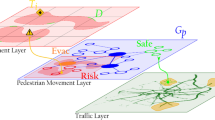Abstract
This paper presents novel computing algorithms to generate tactical risk maps (TRM) based on the MECH (Monitor, Emplacement, and Command/Control in a Halo) model to evaluate locational values for attackers to launch improvised explosive device (IED) vs. direct fire (DF) attacks. Given a study area R, its proximity P can be mapped to explore noticeable characteristics associated with the attack locations. Within the distance constraints of the Halo, a simple optimization formula is proposed to support flexible representations of risk preferences of the attackers in ranking of locations for the M, C and E functions across R. Several case studies on major corridors find a significant number of attack locations were near or at local maxima of the measurement route exposure. It was found that IED sites tend to have good visibility and more uniform line-of-sight (LOS) distances. On the other hand, most DF locations are near the boundary of the viewshed suggesting careful selection of the sites to provide cover in the attack.
This work was supported in part by an ONR grant N00014-12-1-0531 and a National Defense Science and Engineering Graduate (NDSEG) fellowship. Any opinions, findings and conclusions or recommendations expressed in this material are the author(s) and do not necessarily reflect those of the sponsors.
Access this chapter
Tax calculation will be finalised at checkout
Purchases are for personal use only
Preview
Unable to display preview. Download preview PDF.
Similar content being viewed by others
References
Lanchester, F.W.: Mathematics in warfare. In: Newman, J.R. (ed.) The world of mathematics, vol. 4, 2138–2157. Simon and Schuster, New York (1956)
Deitchman, S.J.: A lanchester model of guerrilla warfare. Operations Research 10(6), 818–827 (1962)
Shakarian, P., Dickerson, J.P., Subrahmanian, V.S.: Adversarial geospatial abduction problems. ACM Trans. Intell. Syst. Techno. 3(2), 34:1–34:34 (2012)
Kahneman, D., Tversky, A.: Prospect theory: an analysis of decision under risk. Econometrica 47(2), 263–292 (1979)
Roos, P., Carr, J.R., Nau, D.S.: Evolution of state-dependent risk preferences. ACM Trans. Intell. Syst. Techno. 1(1) 6:1–6:21 (2010)
Okada, I., Yamamoto, H.: Mathematical Description and Analysis of Adaptive Risk Choice Behavior. ACM Trans. Intell. Syst. Techno. 4(1) (2013)
Steinbach, M.C.: Markowitz revisited: Mean-variance models in financial portfolio analysis. SIAM Rev. 43, 31–85 (2001)
Krokhmal, P., Zabarankin, M., Uryasev, S.: Modeling and optimization of risk. Surveys in Operations Research and Management Science 16(2), 49–66 (2011)
Richbourg, R., Olson, W.K.: A Hybrid Expert System that Combines Technologies to Address the Problem of Military Terrain Analysis. Expert Systems with Applications 11(2), 207 (1996)
Janlov, M., Salonen, T., Seppanen, H., Virrantaus, K.: Developing military situation picture by spatial analysis and visualization. In: Presented at the ScanGIS 2005: The 10th Scandinavian Research Conference on Geographical Information Science, Stockholm, Sweden (2005)
George, S., Wang, X., Liu, J.-C.: MECH: A Model for Predictive Analysis of Human Choices in Asymmetric Conflicts. In: Presented at the International Conference on Social Computing, Behavior-Cultural Modeling and Prediction 2015, Washington D.C (2015)
Wang, X., George, S., Lin, J., Liu, J.-C.: Quantifying Tactical Risk: A Framework for Statistical Classification Using MECH. In: Presented at the International Conference on Social Computing, Behavior-Cultural Modeling and Prediction 2015, Washington D.C (2015)
Author information
Authors and Affiliations
Corresponding author
Editor information
Editors and Affiliations
Rights and permissions
Copyright information
© 2015 Springer International Publishing Switzerland
About this paper
Cite this paper
Lin, J., Qu, B., Wang, X., George, S.M., Liu, JC. (2015). Risk Management in Asymmetric Conflict: Using Predictive Route Reconnaissance to Assess and Mitigate Threats. In: Agarwal, N., Xu, K., Osgood, N. (eds) Social Computing, Behavioral-Cultural Modeling, and Prediction. SBP 2015. Lecture Notes in Computer Science(), vol 9021. Springer, Cham. https://doi.org/10.1007/978-3-319-16268-3_42
Download citation
DOI: https://doi.org/10.1007/978-3-319-16268-3_42
Published:
Publisher Name: Springer, Cham
Print ISBN: 978-3-319-16267-6
Online ISBN: 978-3-319-16268-3
eBook Packages: Computer ScienceComputer Science (R0)




